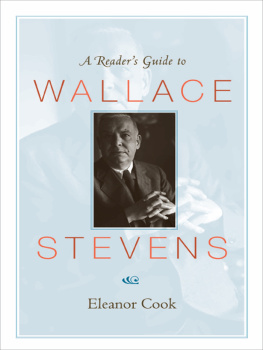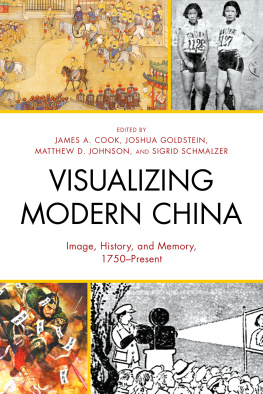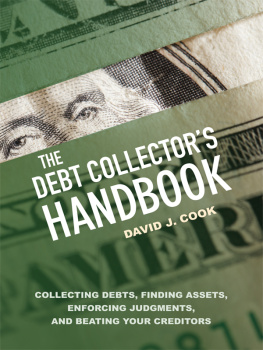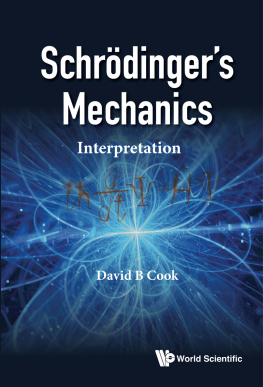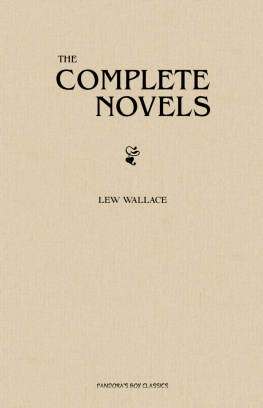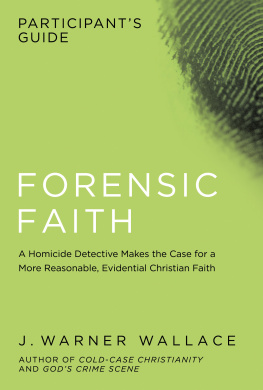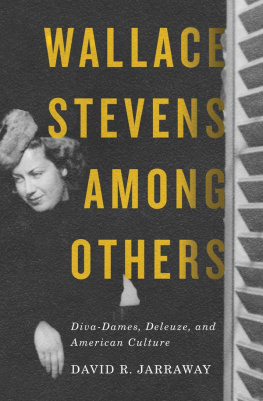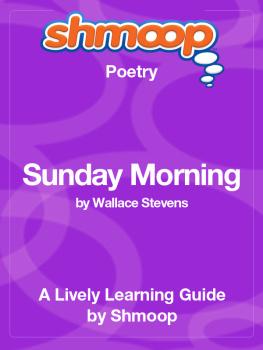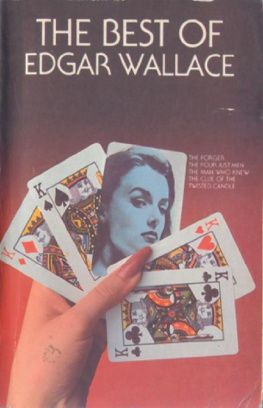Cook - A Readers Guide to Wallace Stevens
Here you can read online Cook - A Readers Guide to Wallace Stevens full text of the book (entire story) in english for free. Download pdf and epub, get meaning, cover and reviews about this ebook. City: Princeton;N.J, year: 2009, publisher: Princeton University Press, genre: Art. Description of the work, (preface) as well as reviews are available. Best literature library LitArk.com created for fans of good reading and offers a wide selection of genres:
Romance novel
Science fiction
Adventure
Detective
Science
History
Home and family
Prose
Art
Politics
Computer
Non-fiction
Religion
Business
Children
Humor
Choose a favorite category and find really read worthwhile books. Enjoy immersion in the world of imagination, feel the emotions of the characters or learn something new for yourself, make an fascinating discovery.
A Readers Guide to Wallace Stevens: summary, description and annotation
We offer to read an annotation, description, summary or preface (depends on what the author of the book "A Readers Guide to Wallace Stevens" wrote himself). If you haven't found the necessary information about the book — write in the comments, we will try to find it.
Cook: author's other books
Who wrote A Readers Guide to Wallace Stevens? Find out the surname, the name of the author of the book and a list of all author's works by series.
A Readers Guide to Wallace Stevens — read online for free the complete book (whole text) full work
Below is the text of the book, divided by pages. System saving the place of the last page read, allows you to conveniently read the book "A Readers Guide to Wallace Stevens" online for free, without having to search again every time where you left off. Put a bookmark, and you can go to the page where you finished reading at any time.
Font size:
Interval:
Bookmark:

A READERS GUIDE TO
Wallace Stevens
A READERS GUIDE TO
Wallace Stevens
Eleanor Cook
PRINCETON UNIVERSITY PRESS
PRINCETON AND OXFORD
Copyright 2007 by Princeton University Press
Published by Princeton University Press, 41 William Street, Princeton,
New Jersey 08540
In the United Kingdom: Princeton University Press, 3 Market Place, Woodstock,
Oxfordshire OX20 1SY
All Rights Reserved
Library of Congress Cataloging-in-Publication Data
Cook, Eleanor.
A readers guide to Wallace Stevens / Eleanor Cook.
p. cm.
Includes bibliographical references and index.
eISBN: 978-1-40082-764-0
1. Stevens, Wallace, 18791955Criticism and interpretationHandbooks, manuals, etc. I. Title.
PS3537.T4753Z62295 2007
811'.52dc22 2006044637
British Library Cataloging-in-Publication Data is available
This book has been composed in Adobe Garamond and Helvetica Neue
Printed on acid-free paper.
pup.princeton.edu
Printed in the United States of America
1 3 5 7 9 10 8 6 4 2
For John Hollander
and Natalie Charkow Hollander
and in memory of
Anthony Hecht
CONTENTS
Wallace Stevens is, by common consent, one of the great Moderns, those major writers in the earlier part of the twentieth century who changed once and for all the way their art is practised. Among poets, there are at least four such Modern masters: W. B. Yeats (b. 1865), Robert Frost (b. 1874), Wallace Stevens (b. 1879) and T. S. Eliot (b. 1888). Other names such as Ezra Pound or William Carlos Williams or Marianne Moore might be added. Among this group, Stevens seems the youngest and the strangest, though he was older than Eliot. But he matured slowly as an artist, and he did not engage in literary polemics designed to further his art, as did Eliot and Pound.
Reaching for a volume by Stevens, readers can be baffled and turn away, as with any new art. Or new art of a certain kind, for much of Yeats and Frost, even when new, was more accessible than much of Stevens. Yet Stevens continues to attract readers, including some who were at first puzzled. His ways of combining words, his wit and seriousness, his pithy and telling affirmations, his gift for titles, his conception and development of a supreme fiction: any or all of these keep drawing readers, including the most diverse readers. Stevens is far from being a poet read chiefly in the academy, demanding as he can be. Perhaps his great attraction is that he knows how to be simple too. Some of the work is straightforward and sensuous, in a Keatsian line of inheritance. (I know people who take it along on holidaysmaximum value for minimum space.) Or perhaps the academy underestimates the number of serious readers outside its domain.
This guide is designed for all these types of Stevenss readersthe knowledgeable, the studious, the enthusiastic, the occasional, the curious, the baffled but persistent. Among students at school, it is designed for those at about a first- or second-year college level (or an advanced high school senior) plus those among their teachers who are puzzled by Stevens. Among more knowledgeable readers, those who specialize in Stevens will find both familiar and new material here.
The best readers guides seem to me to offer both general and specific information, with some judgments and some help in interpretation up to a point. Thus here. Readers will have no difficulty separating matters of fact and matters of judgment or interpretation. This book is centered on the body of work itself, while including whatever biographical and historical information sheds light on the work. It looks primarily at the poems as literature. That is, it offers a guide to help the reader work out what a given poem is saying, and how. (Im aware of challenges of the intentional fallacy in such a statement, and would simply say that I like to follow a poems apparent intentionalities.) This is the reading of a poem that necessarily comes first, before any theoretical approaches such as deconstruction, new historicism, or feminist readings. (Needless to say, these latter approaches may condition or modify an initial reading, but then lots of things modify initial readings, and should.)
The first aim of this guide is to add to the pleasure of reading Stevens through an increased sense of what a given poem is saying. It also tries to demonstrate in passing why Stevens is regarded as a master of his arthow he is innovative, how he finds a voice of his own, how he alters our sense of A or B or C, and more.
Notes to the poems are chronological, concentrating on the six major collections, and following the order of poems in Alfred A. Knopf s Collected Poems, plus the late poems. For the latter, notably those published after the Collected Poems went to press, I have relied on the Library of America edition, Late Poems (195055). To these, I have added the poems in The Necessary Angel. The glosses are keyed to pages in both the Knopf Collected Poems (and Opus Posthumous and The Necessary Angel ) and the Library of America Collected Poetry and Prose. The text of the poems in the Library of America edition is much more accurate than the text in the Knopf Collected Poems, which has never been corrected. (Where useful, I have noted the correct text, but by no means always.) The layout of the Knopf editions is, however, more spacious, and the publication of the Collected Poems and The Necessary Angel was overseen by Stevens himself.
A word or two of caution. First, glosses necessarily try to elucidate the more puzzling words and phrases in Stevenss poems. This may give the impression that his work is nothing but. On the contrary, some of his finest work is straightforward and accessible. Second, all entries list the place that a poem first appeared in print. I have relied on the standard bibliographical work for this information; this guide should not be used as a substitute for close textual editing.
ACKNOWLEDGMENTS
My first acknowledgment must be to the scholars and critics and readers who have added immeasurably to our knowledge and appreciation of Wallace Stevens. This guide could not have been written without them, though limitations of space do not permit individual acknowledgment. (Very occasionally, I have acknowledged a source for a point of fact in the briefest possible way. Citations by author alone refer to items in the bibliography.) Next, the libraries with hidden treasure troves, large and small, as below. First and foremost among these comes the Huntington Library, the main repository of Stevenss books and papers, whose staff makes working there such a pleasure. Beyond other libraries acknowledged below, I should also like to thank the Beinecke Library, Yale University, and the Clara Thomas Archives and Special Collections, York University.
I am grateful to the Social Sciences and Humanities Research Council of Canada for a Research Grant that greatly assisted in the preparation of this book. My two graduate assistants, Sophie Levy and Roseanne Carrara, both of them poets as well as scholars, saved me much legwork and more. At Princeton University Press, Mary Murrell and Hanne Winarsky have been exemplary editors: guiding, patient, encouraging, and full of good humor. I am also grateful to Princeton University Press at large, to Ellen Foos, to my copyeditor and fellow birdwatcher Jon Munk, and to the helpful readers for the Press. As always, my family has given immeasurable support.
For permission to quote from unpublished material in the Huntington Librarys possession (including all WAS listings), I am indebted to the Huntington Library. For permission to quote from all other unpublished material, I am grateful to Stevenss grandson, Peter R. Hanchak, and to the following institutions. Details are provided with quotations in the text.
Font size:
Interval:
Bookmark:
Similar books «A Readers Guide to Wallace Stevens»
Look at similar books to A Readers Guide to Wallace Stevens. We have selected literature similar in name and meaning in the hope of providing readers with more options to find new, interesting, not yet read works.
Discussion, reviews of the book A Readers Guide to Wallace Stevens and just readers' own opinions. Leave your comments, write what you think about the work, its meaning or the main characters. Specify what exactly you liked and what you didn't like, and why you think so.

